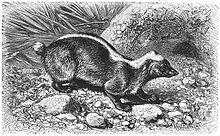Stink badger
They resemble the better-known members of the family Mustelidae also termed 'badgers' (which are themselves a polyphyletic group).
They live west of the Wallace Line; the Sunda species on islands of the Greater Sunda Islands, being Sumatra, Java, and Borneo; in Borneo the badger is found in Indonesia, Malaysia and Brunei.
Stink badgers are named for their resemblance to other badgers and for the foul-smelling secretions that they expel from anal glands in self-defense (which is stronger in the Sunda species).
[4] Stink badgers were traditionally thought to be related to Eurasian badgers in the subfamily Melinae of the weasel family of carnivorans (the Mustelidae), but recent DNA analysis indicates they share a more recent common ancestor with skunks, so experts have now placed them in the skunk family[4][5] (the Mephitidae, which is the sister group of a clade composed of Mustelidae and Procyonidae, with the red panda also assigned to one of the sister clades[6]).
The two existing species are different enough from each other for the Palawan stink badger to be sometimes classified in its own genus, Suillotaxus.

